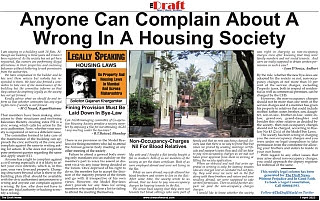Siolim’s Scenic Spiral: When Progress Muddies Legacy
By Gajanan Khergamker
Perched quietly along the Chapora River, the idyllic village of Siolim once epitomised Goa’s understated charm — its winding lanes, baroque chapels, and coconut-lined estuaries forming the perfect backdrop to tales of camaraderie, culture, and calm. But, in the relentless march of time and tourism, the picture has begun to blur. Today, Siolim finds itself teetering on a precarious precipice — between tradition and turbulence.
At the heart of this transformation lies a simple paradox: Development without direction. Siolim, like much of North Goa, has become a playground for the well-heeled and the weekender, its real estate mushrooming with a ferocity that belies regulation. And, as with most things unregulated, the cracks have begun to show.
 |
| Siolim's issues reflect the surge in the usual scourges associated with unbridled tourism |
The influx of high-value tourism has fuelled an insatiable demand for private villas and boutique homestays. Consequently, lands that were once the bastion of Mundkars and traditional tenants — often undocumented but socially secure — are now being pried open by the chisels of property sharks. The courts remain cluttered with tenancy disputes where legacy residents find themselves pitted against well-connected outsiders wielding sale deeds and muscle.
In one such case, a 12-year-long legal battle culminated in the demolition of what some claimed was an ‘illegal house.’ The residents? Mundkars who insisted their right to remain had been trampled under the pretext of legality. The State, slow and often complicit, looked the other way — a now-familiar refrain in the region.
The infrastructure, if it can be called that, hasn’t kept pace. Roads are dug up under the pretext of cable-laying or drainage works and left gaping like open wounds. The tragic case of a man in Marna who fell into a ten-foot ditch while riding his scooter is a stark reminder of administrative apathy. The holes, quite literally, lie in plain sight.
Add to this the lack of a robust sewage and garbage disposal mechanism, and Siolim’s monsoon metamorphosis becomes a public health hazard. Overflowing nullahs, plastic-choked rivulets and the omnipresent stench of neglect offer a reality that no villa’s infinity pool can mask.
For locals, summer is not just about heat but thirst. Borewells, bored indiscriminately by commercial establishments, have drained traditional water tables dry. While luxury properties tank up using private suppliers, villagers are left queuing for municipal tankers. The inequity is stark, yet shrugged off as ‘collateral damage’ in the march towards progress.
Siolim’s charm has also made it a soft target for unlawful tourism. Rooms are rented to foreigners without registering with the Foreigners Regional Registration Office — a mandatory process conveniently bypassed. The recent arrest of an Israeli national, a suspected drug dealer housed unlawfully by a local resident, unearthed what insiders have long known — Siolim is on the radar of cartels.
While police crackdowns make headlines, the larger network — built on silent consent and administrative oversight — continues to thrive. It's not a question of enforcement but will. And, in Goa’s notoriously sluggish enforcement ecosystem, will is a rare commodity.
In the shadows of this ‘development,’ Siolim’s cultural fabric quietly frays. The Zagor — a traditional folk drama — and the exuberant São João festival may still be celebrated, but their spirit is increasingly commercialised. Boisterous floats, once heartfelt community efforts, are now spectacles designed for Instagram. What was once sacred is now staged.
The elderly lament not just the changes but the speed and scale of their onset. They speak of a time when the fields were green, the river clear, and the community strong. Today, the fields are being flattened, the river is choking on plastic, and the community? It’s divided — between those cashing in on tourism and those drowning in its detritus.
What makes Siolim’s spiral particularly tragic is its avoidability. The issues — drainage, tenancy, unlawful rentals, environmental degradation — are not novel. They’ve been festering for years, dismissed as growing pains. But when the pain becomes chronic, ignoring it is no longer an option.
Unless addressed with the urgency they merit, Siolim risks becoming a cautionary tale — a village that had everything but lost its soul in pursuit of someone else’s paradise.



